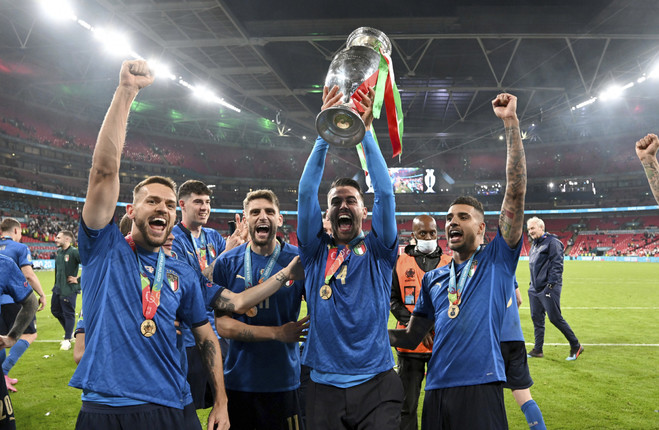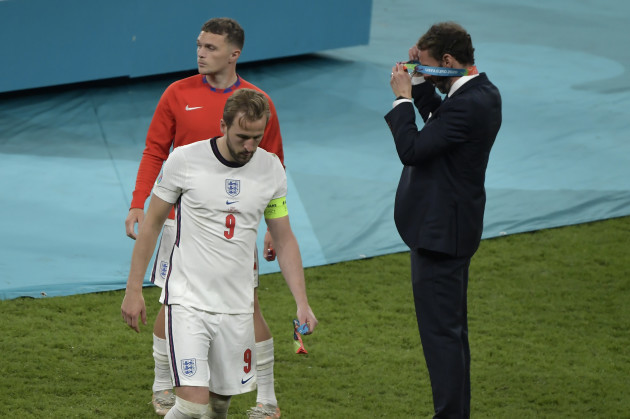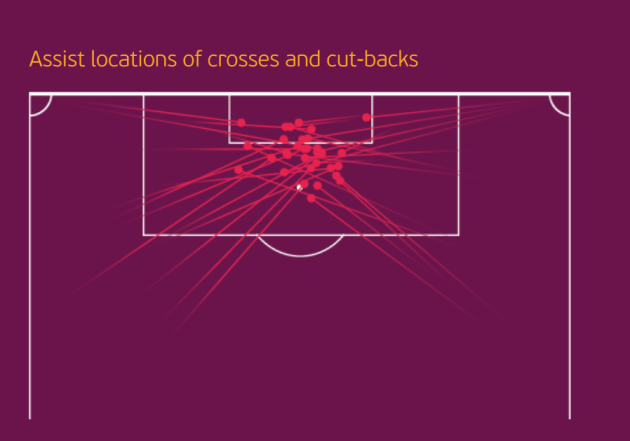UEFA HAVE RELEASED their technical report on Euro 2020, a tactical breakdown of the tournament led by their crack team of football experts, which included FAI board member Packie Bonner and FAI employee Robbie Keane, alongside the likes of David Moyes, Esteban Cambiasso, and Aitor Karanka, all under the leadership of il mister, Fabio Capello.
The report in full can be read here.
Alternatively, if you don’t feel like wading through its 50-odd pages, we’ve picked out some of the insights they gleaned from the summer’s tournament.
A break-out tournament for The Back Three
Ireland switched firmly to a back three system in March, and thus anticipated the trend of Euro 2020.
15 of the 24 teams at the tournament used a back three system at some point, and David Moyes said at the end of the group stage that the sides playing 3-4-3 looked better, counselling England to change their approach for the upcoming last-16 tie with Germany. (England did exactly that, matching Germany with a back three.)
Remarkably, full-backs and wing-backs scored 16 goals at Euro 2020: at the previous Euros, that position collectively delivered a single goal. And of those 16 goals, 12 were scored against a team playing a back four.
Only one of the 24 sides played a 4-4-2 – Sweden – which was down from five at Euro 2016.
But for all its popularity, the report raises questions as to whether the back three system was the most effective, citing the final, as England (3-4-2-1) lost on penalties to Italy (4-3-3.)
“Initially England’s wing-backs – and the overloads they helped to create in wide areas – gave Italy a rough ride. But then, with Jorginho conducting the orchestra, they fought back into the game by taking control of that central midfield area, obliging Gareth Southgate to switch to a back four midway through the second half. The jury is still out…”
England made to pay for their long-ball game
So, what went so wrong for England in the final? They started superbly, took a near-instant lead through Luke Shaw…and then didn’t have another shot on target and lost on penalties.
In the early stages, David Moyes says it looked as if England’s wing-back system “had caught Italy out”, with Packie Bonner remarking that he looked over his notes and, 17 minutes in, hadn’t written a single word about Italy, praising England as “tactically excellent.”
But then it all changed, with Austrian coach Will Ruttensteiner pointing out that Roberto Mancini made a few subtle positional changes in order to get around England’s press and allow the ball into the feet of midfielder Jorginho.
With Italy hogging the ball – England’s possession share dropped to 35%, their lowest of the competition – Southgate’s side started playing more long balls than they had at any stage of the competition to date.
This, says Packie Bonner, swung the game.
“When you use wing backs, you need to play out from the back and have a good share of possession. When England started to give away possession they started to lose control of the game. When Jordan Pickford felt obliged to play it long, the wing backs found it difficult to get into attacking mode and [Harry] Kane was losing the ball in the air instead of being able to drop deep and receive along the ground.”
The end for “hopeful high balls”
Crossing proved a fruitful means of scoring at the Euros, though these were not ‘stick-in-the-mixer’ hoiks.’
But given the fact so many teams played with wing backs central areas were so clogged, wing play became a vital means of breaking down opponents at the Euros. These were not “hopeful high balls”, says the report, but instead they were largely accurate in-swinging crosses from the top of the box and driven pull-backs from the endline.
Crosses led to the highest percentage of open play goals scored at the tournament, and was a factor in the record number of 11 own goals, says Dutch coach Frans Hoek. “It’s incredibly difficult to defend. There is so much pressure in front of goal and, if a defender gets to the ball, it’s a corner or an own goal.”
Forget what you knew about the playmaker
“The playmaker is no longer the No.10″, writes Fabio Capello. “It’s the organiser in front of the backline.”
These days, says the report, the playmaker is less about directly creating goals than it is about dictating the pace of a game and offering balance to a side, with Jorginho and Sergio Busquets offered as examples of the modern-day playmaker.
“[Jorginho] could find space when the team needed him and he was a leading figure”, says Ruttensteiner. “When Italy were trying to make their way out of a high press, he would often make himself available and quickly switch play to the other wing.”
The importance of set pieces
Set pieces accounted for 28.2% of the goals at Euro 2020, with champions Italy replicating that ratio by scoring almost 30% of their goals from dead balls.
And Italy were certainly well-drilled: their coach Gianni Vio has almost 5,000 different set piece routines in his notebook.
Dribbling is back
“This is the Euros of dribbling”, proclaims Capello, praising Kylian Mbappe, Raheem Sterling, Lorenzo Insigne, Federico Chiesa, and Leonardo Spinazzola in “resuscitating” a dying art.
Capello praised the players for taking a risk in dribbling, and heaped praise on Sterling as England’s main threat.
Possession is not everything
Uefa’s report says the game has changed from Spain’s dominant era, in which possession seemed to be the full ten-tenths of the law.
“Ball possession and the amount of passing during the game does not guarantee success”, says Ruttensteiner, a point developed by Spanish coach Gines Melendez. “One of Spain’s major strategies may no longer be a key to success. What is important is to have tactical order and discipline, which is why Denmark and Sweden surprised me a lot as they are tactically strong.”
The statistics show that of the five sides that ranked highest for average possession per game, only Spain made the semi-finals. Italy ranked sixth; England tenth.



